Bluey team: ‘There will definitely be more’
After three successful and record-breaking seasons, the creative team behind Bluey have revealed what will come next for Australia’s favourite pup.
QWeekend
Don't miss out on the headlines from QWeekend. Followed categories will be added to My News.
Joff Bush sits in his South Brisbane studio, picks up his melodica, blows into the tube and begins to play. And if you’re a young child – or a parent of one – chances are you will immediately recognise the tune.
It is the rise and fall of the notes that are the theme song of Bluey, the beloved children’s television juggernaut, made out of Ludo Studio in Brisbane, about a cartoon family of blue heelers with parents Bandit, Chilli and daughters Bingo and Bluey.
“It’s a pretty weird song when you think about it,” smiles Bush, 38, who is Bluey’s lead composer and the writer behind that tune, which is now one of the world’s most iconic children’s television theme songs. “It’s got no drums, it’s got melodica (a handheld instrument almost like a keyboard harmonica), baritone sax, which is a real testament to the producers and to Joe Brumm (Bluey’s creator) as well for giving it the thumbs up.”
Bush is, like all the Bluey team, as modest as they come, but the team’s instincts are powerful.
Bush, who grew up in Brisbane’s south in West End, admits he was never “a prodigy kid”, firing off jokes about the Cs he would get on his early piano reports.
He practised obsessively until he found what made sense, and when he did, he transformed into who he is now: a brilliant composer helping to quietly propel an award-winning and record-breaking children’s cartoon into a league of its own. Bluey’s enormous success can be credited to the ingenious writing, themes, characters, humour, wit, and relatability – but among the hidden ingredients in its magic formula is the music. “Half of what you see is visual and half of it is music,” says Bluey’s executive producer and Ludo Studio co-founder Daley Pearson.
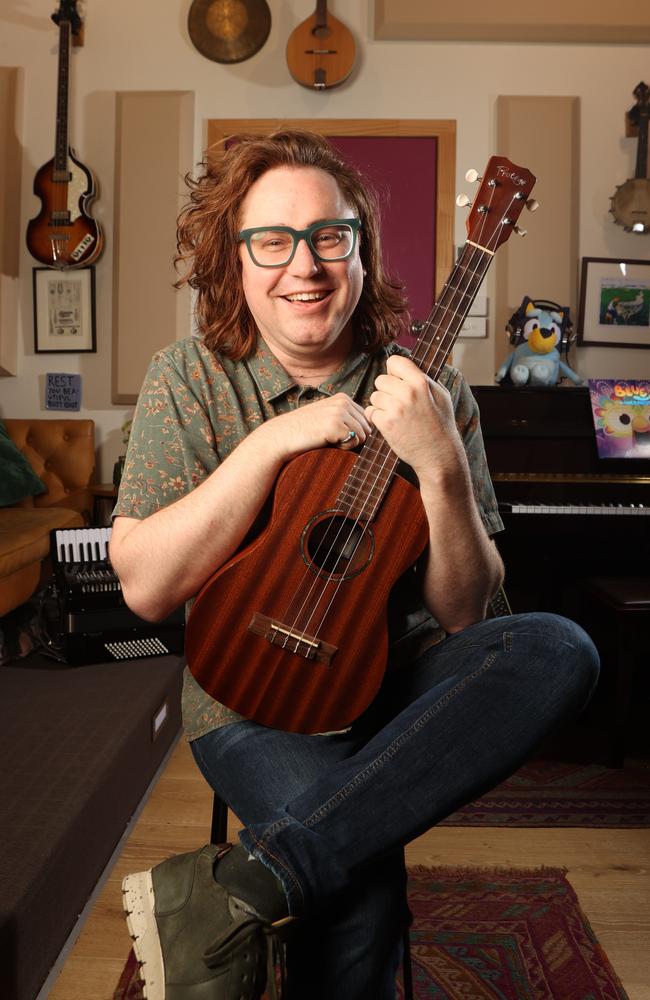
“What is really great about Joff is how he’s able to bring out what’s already there and make it better.”
Pearson has been a fan of Bush’s work since the pair met at university and says his friend is still the eccentric composer he met at 17.
“He generally consults with you in the day, talking over things, then he works while you’re asleep,” he says. But Pearson knows his “genius” friend will always deliver the magic.
Bush creates scores as unique as the show’s narrative, citing musical references including Concerto a Due Cori No. 2 by Handel (in the Seesaw episode) or Spring by Vivaldi (in Fancy Restaurant) and creates everything from simple piano melodies to dance music. His work was heavily praised by musical genius and man behind the smash-hit musical Hamilton,
Lin-Manuel Miranda, on Miranda’s trip to Brisbane in March. “When screens are not allowed in our house, we’ll put on the Bluey soundtrack,” he told The Australian. “The music is part of what makes it so extraordinary.”
Miranda’s support, alongside that of other celebrities including singer Billy Joel and US talk show host Jimmy Fallon, have played a role in the popularity of the show internationally.
Since Bluey launched in the USin September 2019 on Disney Junior and later Disney+, its success has exceeded all expectations.
“It’s a great feeling,” says Brumm. “In the beginning I asked our crew to help me make a beautiful cartoon. That’s what we’ve been doing, and to see it embraced by the rest of the world is so satisfying.”
After Bluey’s Big Play – the stage adaptation of the show – enjoyed a successful run in Australia, it debuted at New York’s Madison Square Gardens last year. The response was so big the 40-date tour extended to more than 150 cities, which will take it to a nearly two-year tour. Last November, a giant inflatable Bluey, as tall as a four-storey building, floated down the streets of New York when it joined the Macy’s Thanksgiving Day Parade for the first time.
The homegrown show was named in May by The Hollywood Reporter as the number one streamed show in the US with viewers watching 737 million minutes.
Kate O’Connor, head of licensing and brands at BBC Studios ANZ, says the “Aussie-ness” of Bluey is embraced by overseas audiences and will always remain. “Although now it’s dubbed into 30 languages around the world, we still make a conscious effort to keep the Australian humour and sensibility, not to mention all those iconic Aussie things like meat pies, bin chickens and State of Origin,” she says.
“Bluey has this incredible ability to be both quintessentially Australian and also universally relatable. It’s a hard thing to do but Bluey has nailed it.”
In Australia, its formidable influence has long been acknowledged, although it’s still a shock for Pearson. “I know there is something very special about Bluey but I never expected this reaction,” he says.
“Everyone has worked hard enough that I think they have earned this success but nobody ever expected that by any means.”

The acclaim it’s racked up is impressive, with highlights including: It’s the number one program ever across all broadcaster video on demand platforms in Australia, the highest rating program in the history of ABC Kids and an episode of Bluey named Cubby broke the ABC Kids record for the highest broadcast audience since records began in 2008 with an overnight total audience of almost 1.5 million viewers.
It was recently announced to have had the highest total audience achieved by any series to air in Australia with 11 million viewers, higher than MAFS and the Tokyo Olympics Opening Ceremony in 2021.
Then there are the awards: Logies, an Emmy, a BAFTA (British Academy of Film and Television Awards) and a swag of AACTAs (Australian Academy of Cinema and Television Arts Awards). Bluey is available in more than 60 countries.
More than 1000 Bluey products are available globally ranging from clothing and toys to dairy products and snack foods and it’s the first Australian brand on Colgate toothpaste. It’s an incredible feat for the show born from conversations, situations and scenarios Australian families experience, then ingeniously turned into seven minutes of gold by the team including Brumm, Pearson, executive producer and Ludo co-founder Charlie Aspinwall, producer Sam Moor and of course, Bush. The team delivers emotion, heart and humour in spades with particular episodes, like the recent Cricket, capturing the attention of the nation.
Yet five years on from when Bluey launched on Australian screens in 2018, Bush still can’t grasp the impact it – and he – has had.
“I have no concept of it,” he laughs of his music and the show’s popularity. “It’s been so popular in Australia almost from the get-go but it’s been a slow burn for everywhere else, now it’s getting to this point where people are discovering it and it’s great.”
Even more surprising to Bush, however, is how his music is earning its own recognition.
It’s achieved what no Australian children’s television show ever has. Bluey The Album, released in 2021, debuted at No. 1 in Australia, making it the first Australian children’s album to top the ARIA Albums chart. It made it to No. 1 in the Billboard Kids chart and No. 6 in the Billboard Soundtrack chart in the US. It’s had more than 200 million streams globally.
Bush subsequently won Best Children’s Album at the 2021 Aria Awards and two Screen Music Awards for best soundtrack album and best music for children’s programming in 2022.
Bush kept up the momentum with the release of the second album, Bluey: Dance Mode, in April this year. It’s already topped the Billboard Kids chart in the US and made it to No. 7 on the ARIA Albums chart in Australia as well as No. 2 in the Vinyl chart. In one week, global streams reached 3.2 million.
“It’s so beautiful but it isn’t what motivates me, it’s a nice feather in the cap to have but it just lets me hopefully do cooler things and keep going on the things I want do to,” Bush says.
Which, he says, is to create.
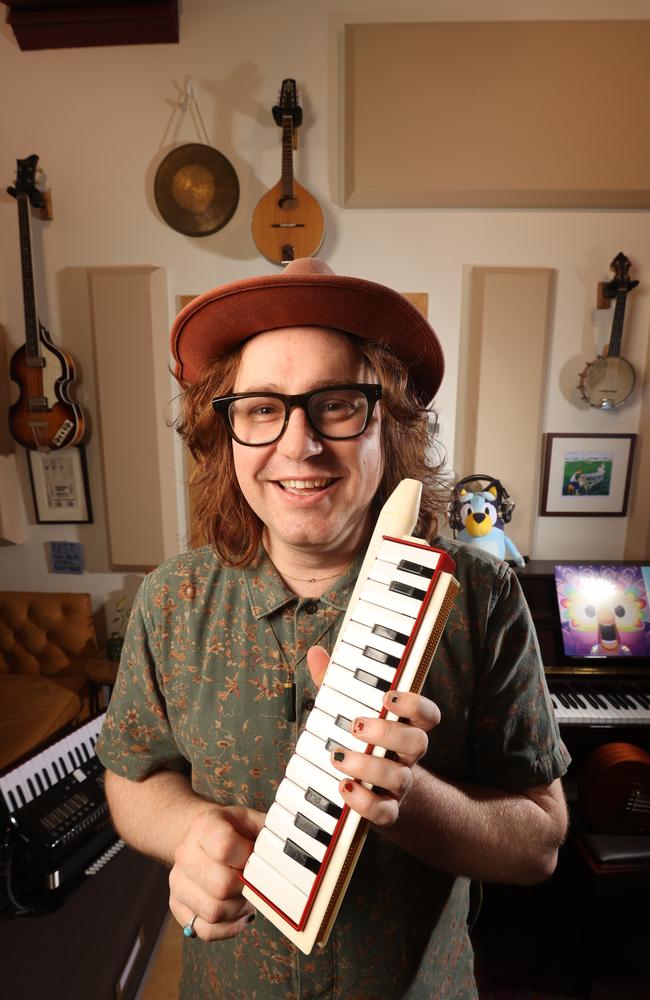
Bush moves between his piano stool, office chair, and couch in his one-room studio in West End. It is a modest space with Bush’s greyhound coiled on the mustard couch, instruments of all types scattered about and Bush’s favourite pieces of art on the walls. “You need help,” one reads, written in a child’s scribble, accompanied by a drawing of what Bush jokes is a sketch of him. “It’s a big blob,” Bush laughs. “My cousin’s son drew that for me when he was eight and I thought it was the funniest thing, I still do.”
It is one of two things Bush takes with him to any of his studios. The other, a paradise landscape hanging high on the wall. “It was payment for my first ever gig,” smiles Bush. “I played (piano) at the house of an artist when I was 13 for a Christmas party, they were family friends, and that was my payment.”
Bush’s early dream was to be a concert pianist. He was chuffed when he scored a gig playing piano outside Brisbane’s QPAC on show nights at 14. “I freaked out right away,” says Bush, who was born in Wagga Wagga in NSW before moving to Brisbane aged 12. “I was wearing an oversized suit that I borrowed from somebody, or maybe my parents, and just ran away … they didn’t even notice,” he jokes.
Eventually he came back, sat down, started to play and made people listen and they’ve never stopped listening. “I always loved music but I was never very good at it,” he confesses. “I was never a prodigy, I was the opposite of what people would expect.
“All my childhood piano reports were C- at best, it’s amazing how bad I was,” he pauses, then smiles, “or maybe I hadn’t found it yet.”
By the age of 15 the unique way he understood and interpreted music was validated.
He sat at QPAC and watched French piano group, Jacques Loussier Trio, perform L’Isle Joyeuse by composer Claude Debussy. “I let the music wash over me and thought, ‘Oh man, this is the most beautiful thing in the world.’ Even if I’m not great at it, I have to do this.”
Bush studied a Bachelor of Music in piano and composition at the Queensland Conservatorium, where he met Pearson. Pearson was studying at the Griffith Film School and used to make “all these bad films” and borrow equipment from the Con. A mutual friend introduced him to Bush and a lifelong friendship and dynamic working relationship soon followed.
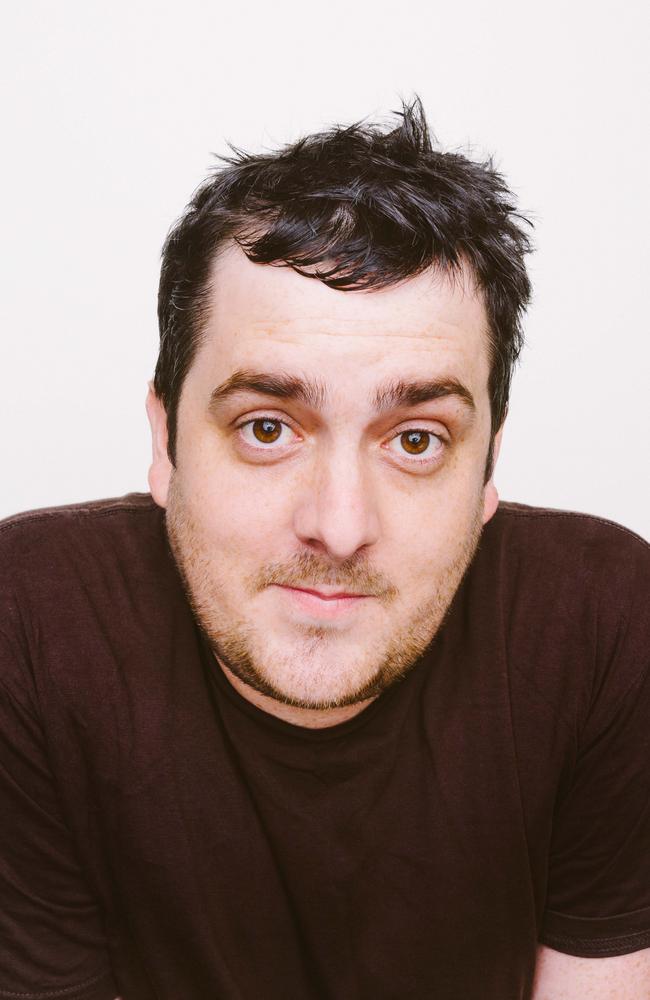
Whatever Pearson worked on, he’d ask Bush to be part of, laughing over the early projects.
“There was a stupid comedy about landscapers who couldn’t landscape a park because of a magpie,” Pearson says.
But along came Pearson’s first major project commissioned by the ABC, The Strange Calls, a 52-episode series which, of course, he called in Bush to score. “I think that made us both take it pretty seriously,” remembers Pearson.
“I remember bringing around the professional ABC people, like the broadcasters and producers (to Joff’s studio), and Joff was asleep in this dark room, it was like a bat cave and really messy.
“I told them he was a genius and how he was so brilliant and makes everything better and then they saw this room,” he laughs, “I think they thought it was this lazy student wasting money but he delivered, and it was brilliant.”
Pearson is effusive in his praise saying, “There hasn’t been anything I haven’t asked him to work on.”
But there was one show Bush almost declined and it was the one that would change their lives.
The pair was making The Strange Calls but Pearson was quietly working on another project called Bluey. Naturally, he wanted his friend to join him but Bush almost knocked it back.
“I hadn’t really done typical kids’ music before and I was worried about being so busy on The Strange Calls and I didn’t know if I was going to have time to do it,” Bush says. But once he saw an episode, and its brilliance, he was in. Bush elevates any project he works on, Pearson says, and pinpoints exactly what the secret is.
“He is the first guy I worked with, and it was a surprise to hear from a composer who said, ‘Well, what’s the character feeling? What perspective is the score coming from?’” says Pearson. “We were 17, I don’t even know if he knew what he was talking about but it sounded impressive.
“Then we did start writing scores from the characters’ point of view, driven by Joff.
“What is the music saying? Whose character is the music? Whose mind are we inside? What are we trying to tell people? I think Joff was the first person who spoke to me like that.”
Simple, yet it changed the game for Pearson.
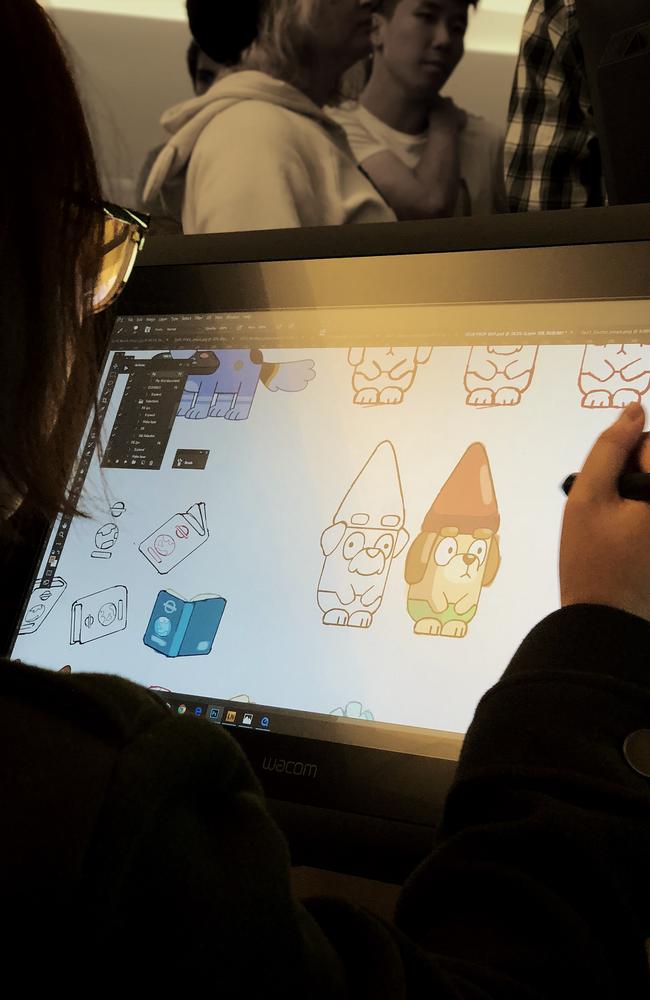
Bush offers a glimpse into the process behind his next brilliant idea. “I’m going to be so embarrassed by this,” Bush says, crumpling his face in doubt, “Why am I showing you this?”
Bush scrolls through an endless ream of voice notes he’s recorded into his phone. “This is the most recent one, it’s absolutely awful,” he says with a laugh. There’s the sound of footsteps on floorboards, doors opening and closing and Bush’s voice floating over the top. He’s walking and workshopping melodies and concepts. Some develop and are helped along with a team of composers and musicians and some never see the light of day, he jokes.
But each episode requires a different approach and they all require him to dig deep.
“It does mean you have to go to certain places emotionally yourself which can be really hard,” he says noting an episode called Sleepytime where we’re taken inside the dream of Bingo, Bluey’s sister, with the narrative navigating a sleep-deprived family. “I watched that one 200 times and I was a mess after that.”
Other times, though, it’s just pure fun … like creating the theme song, which he reveals might never have seen the light of day. “There was a time when they were thinking of not having a theme song or using tracks from Brisbane bands or using licenced music rather than creating its own musical identity,” Bush says.
“I hope I’m not giving the wrong story but I do remember saying, ‘Look, please let me have a go with this thing, I really want to do a theme song for it’ because it felt like it deserved to have something that was its own.”
It started, as it always does, with a voice note. After eight drafts and the first one on the melodica, he played it to Brumm, who immediately loved it. Brumm suggested he use the beginning melody on loop and … voila. Bush says it perfectly accompanied Brumm’s concept of a game of musical statues for the opening sequence and jokes about how it all came together, “I fluked it!”
“It wasn’t like we had a big budget to record heaps of instruments (for Bluey) and part of the sound came out of this guitar,” he says strumming the strings. “It’s my favourite guitar and I think it was $100 from a second-hand store, I think we used this one on Turtle Boy.
“A lot of the instruments (on Bluey) are old or broken.” As a muso, he’s wholeheartedly ready for the ride but admits it’s been demanding, a sentiment echoed by Pearson.
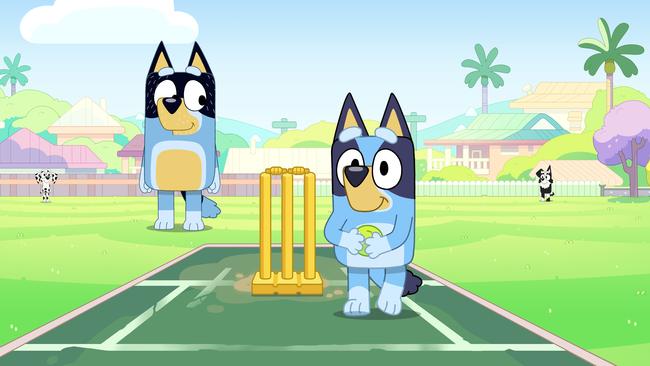
The show’s wild success has been rewarding but, at times, exhausting. Pearson talks candidly of the team’s decision to take a short break from making episodes. “We are just going to get our heads on a bit, it’s been four or five years and we’ve made 154 episodes, it is kind of unprecedented to do that back-to-back. It was very intense … we are just coming to the end of season three and trying to think about what’s the best way to make it better.”
He is, however, quick to squash rumours Bluey ends with season three (which is airing now), saying, “There will definitely be more Bluey”, and they just need a breather.
“We have all secretly agreed with each other that we wouldn’t keep making Bluey if it wasn’t as good as the one that came before, so we want to make sure we keep doing that,” Pearson says.
“Part of it is just not pushing to come back. We are resting; the more we ask ourselves (when work will begin on season four), the longer it will be, which is why I hesitate talking about it too much.” It takes heart and soul, Pearson says, to create a show like Bluey, acknowledging the influence they have on households worldwide.
“The amount of families who have taken Bluey in and trust this show with their kids, it’s a privilege that we don’t, and have never, taken lightly … ever,” he says.
Pearson doesn’t have a definitive answer to when fans can expect another season. In the meantime, the team has made a series of Bluey “shorts” to tide fans over.
The world can’t get enough. It’s an extraordinary achievement for the show. One which Pearson helped create with Aspinwall to nurture Brisbane talent. “Mostly it was really selfish,” he laughs of creating Ludo in Brisbane.
“We just didn’t want to leave. We wanted to create an industry in Brisbane and not just for people who make great stuff but who make great stuff which is created here.”
Pearson, Bush and the team are grateful they will always be connected to the show that defined a decade. Bush reflects on just how significant the cartoon has been to him.
“I’m very proud of it, it’s wild to have made something, or been part of something that’s so loved and is now part of the Zeitgeist of the world, can I say that?” he says blushing. As fans eagerly await what’s next for Bluey, Pearson shares his thoughts for a potential Bluey movie. “It would be a dream. We just have to make sure we have the time and the right idea.”
Until then, Bush has a dream of his own.
“I would love to do a live show playing with all my favourite musician friends,” he says.
“The dream is to play at a Grade 4 disco.
“Maybe in 20 years’ time all these kids will be (listening) to it in the clubs … that would be
so great.”





